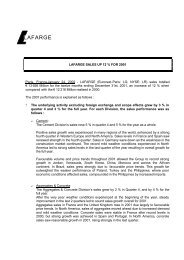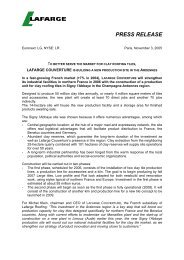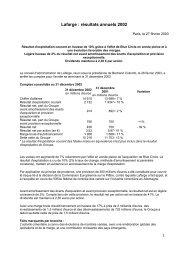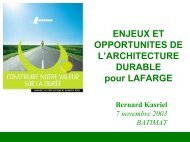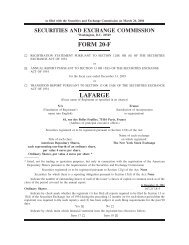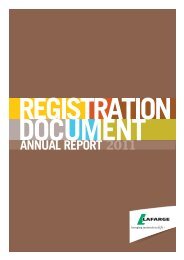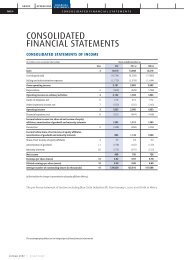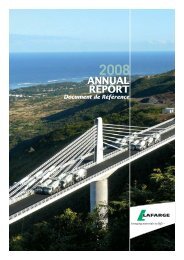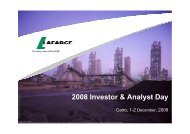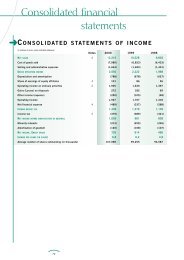2005 Sustainability Report - Lafarge
2005 Sustainability Report - Lafarge
2005 Sustainability Report - Lafarge
Create successful ePaper yourself
Turn your PDF publications into a flip-book with our unique Google optimized e-Paper software.
Protecting the environment<br />
Fighting climate change<br />
CUTTING BACK ON CO2<br />
EMISSIONS<br />
The building materials industry is a<br />
major source of CO2 emissions. Cement<br />
production alone accounts for close to<br />
5% of worldwide emissions of human<br />
origin. The emissions of the <strong>Lafarge</strong><br />
Group are mainly due to cement<br />
production.<br />
Upon the renewal of its partnership<br />
with WWF, the Group reiterated its<br />
commitment for the coming years to<br />
reduce its direct emissions from the<br />
Cement business:<br />
• reduce its absolute gross CO2 emissions<br />
by 10% in industrialized countries 2<br />
over the 1990-2010 period;<br />
• cut its worldwide net emissions 3 by<br />
20% per tonne of cement.<br />
From 2006 onwards, this partnership<br />
will look at ways of helping developing<br />
countries cut back on CO2 emissions<br />
from the construction industry.<br />
Half of the cement industry's emissions<br />
derive from the limestone decarbonatation<br />
process, 40% from fuel combustion<br />
and the remaining 10% from the use of<br />
electricity and transportation. Driven<br />
by its partnership with WWF, <strong>Lafarge</strong><br />
is already achieving very encouraging<br />
results. To reduce its emissions, the<br />
Group is harnessing four main levers:<br />
• replacing carbonated raw materials<br />
with already decarbonated materials;<br />
PAGE 20 | <strong>2005</strong> SUSTAINABILITY REPORT | LAFARGE<br />
In the long run, we believe that all necessary action should be taken to cap<br />
the global average temperature increase to a maximum of 2°C1 . Since 2001,<br />
<strong>Lafarge</strong> has made a voluntary commitment to reduce the CO2 emissions<br />
generated by the worldwide scope of its operations. With this ambitious policy,<br />
the Group intends to preserve its lead while continuing to drive the entire sector<br />
forward in this direction.<br />
• replacing fuels (use of alternative<br />
fuels, notably biomass);<br />
• improving energy efficiency by<br />
modernizing plants and processes;<br />
• using clinker additives (slag, fly ash,<br />
limestone, pozzolans, etc.).<br />
BUILDING FOR THE<br />
FUTURE THROUGH<br />
LARGE-SCALE RESEARCH<br />
PROGRAMS<br />
We are currently exploring new ways<br />
of achieving reductions:<br />
• modifying the chemical composition<br />
of clinker, to generate less CO2 during<br />
its production;<br />
• identifying more energy-efficient<br />
processes;<br />
• optimizing the overall formulation of<br />
concrete and recycling concrete.<br />
Investments in these programs amounted<br />
to €3.4 million or 14% of research<br />
expenditure in <strong>2005</strong>.<br />
> See indicators p 40 and 41<br />
In addition, we are participating in<br />
research programs such as capture<br />
and storage of CO2 to understand and<br />
anticipate the ways in which these<br />
technologies will impact processes in<br />
our plants.<br />
1 | This represents a public position taken by <strong>Lafarge</strong>.<br />
2 | Climate Change Convention Annex I countries + Serbia + Moldavia.<br />
3 | Net emissions = Gross emissions - Emissions from waste combustion.<br />
LAFARGE'S PARTICIPATION<br />
IN THE EUROPEAN<br />
EMISSIONS<br />
TRADING MARKET<br />
Following the launch in <strong>2005</strong> of the<br />
European CO2 emissions credit market,<br />
<strong>Lafarge</strong> was awarded emissions permits<br />
in ten European countries. These permits<br />
accounted for around 25 million tonnes<br />
of CO2. The quotas were distributed<br />
on an adjusted basis and broadly cover<br />
our needs from <strong>2005</strong> to 2007.<br />
Net result from purchases and sales<br />
of quotas accounts for less than 1%<br />
of the operating income of the Cement<br />
business in <strong>2005</strong>. We support the<br />
introduction of this system as an incentive<br />
to reduce CO2 emissions, in line with<br />
the commitment we made in 2001.<br />
> See our detailed public position<br />
on page 14<br />
Clean Development<br />
Mechanism (CDM)<br />
project which substitutes<br />
alternative, biomass<br />
energy sources<br />
for fossil fuels in two<br />
of <strong>Lafarge</strong> cement plants<br />
in Malaysia.




